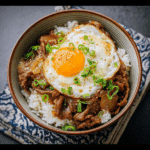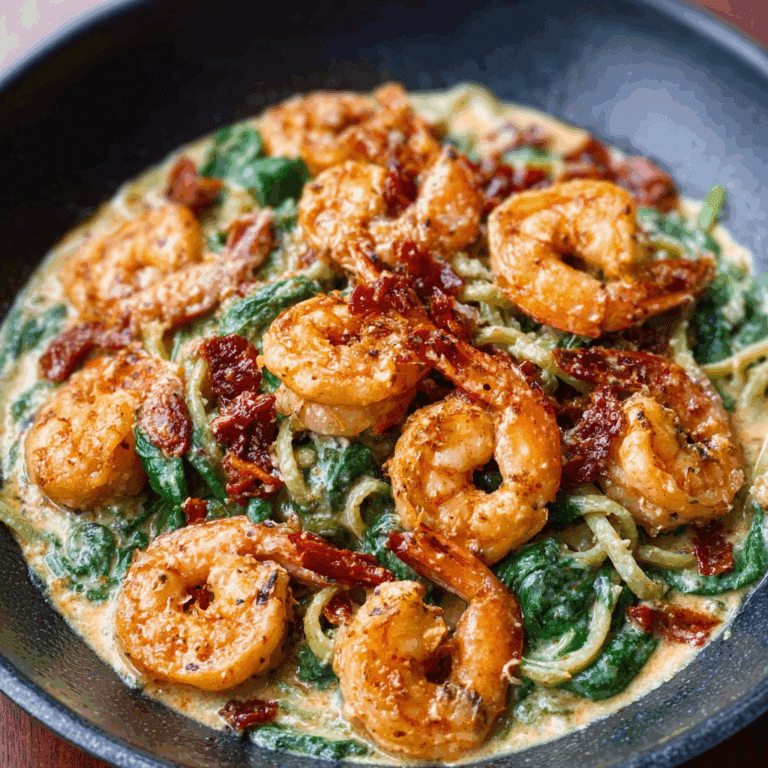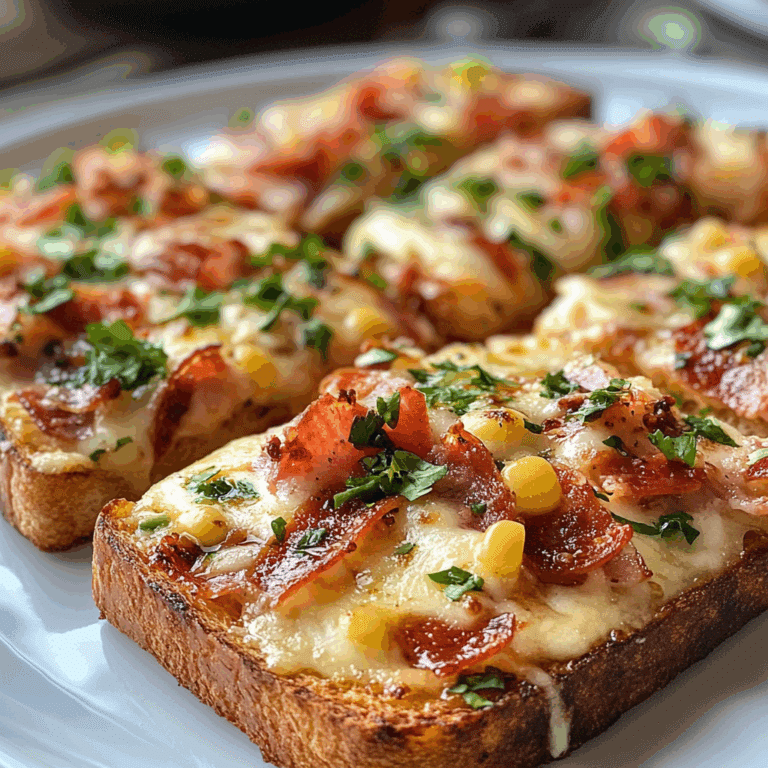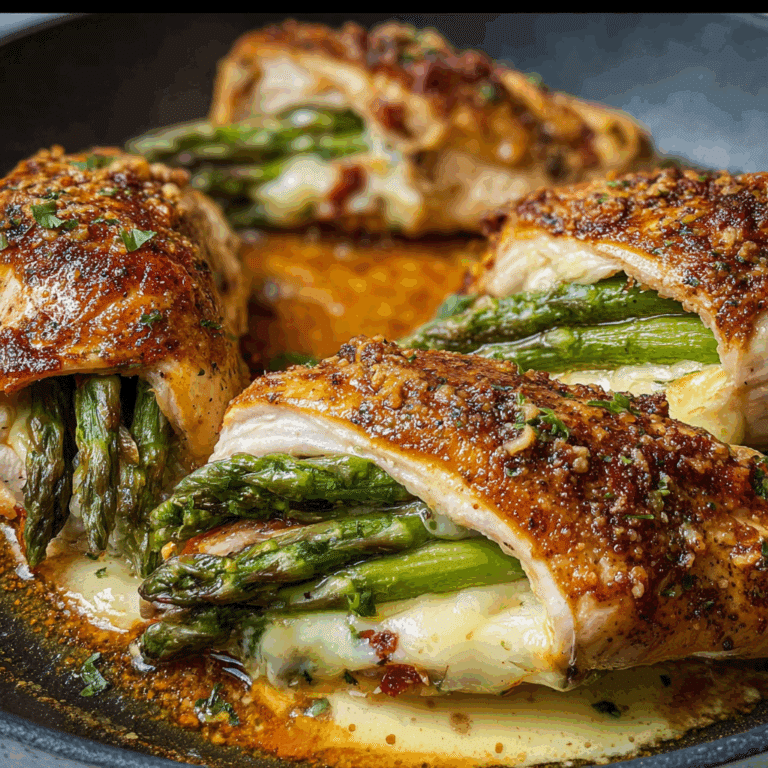Quick Gyudon Japanese Beef Bowls with Rice and Eggs Recipe
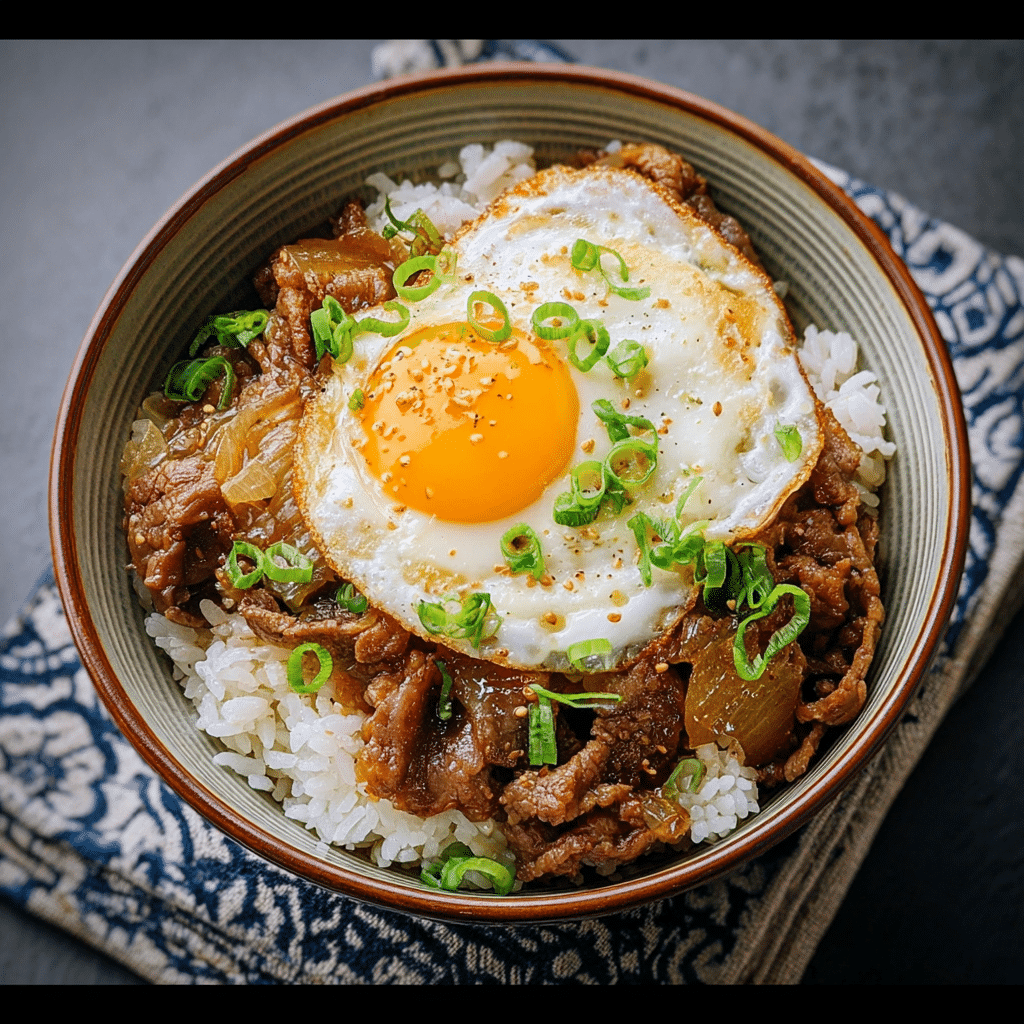
If you’re craving a quick, savory meal that’s bursting with umami, you’ve got to try this Gyudon Japanese Beef Bowls with Rice and Eggs recipe. It’s a beloved Japanese classic that combines tender slices of beef, sweet and salty sauce, fluffy white rice, and soft-cooked eggs for that perfect creamy finish. This dish is simple enough to whip up on any busy day, yet so flavorful that it feels like a special treat every time. Whether you’re new to Japanese cooking or a seasoned fan, this recipe is a game-changer for anyone looking for a hearty, satisfying meal in minutes.
Why You’ll Love This Recipe
- Quick and Convenient: Ready in under 20 minutes, it’s perfect when time is tight but hunger is big.
- Rich, Balanced Flavors: The blend of soy sauce, mirin, and dashi creates a savory-sweet profile that complements the beef beautifully.
- Comfort Food Quality: The warm rice combined with tender beef and runny eggs creates an incredibly comforting bowl.
- Simple Ingredients: Uses everyday pantry staples without sacrificing taste or authenticity.
- Customizable: Easy to adjust for spice lovers, vegetarians, or anyone wanting to add a personal touch.
Ingredients You’ll Need
This Gyudon Japanese Beef Bowls with Rice and Eggs recipe uses simple, straightforward ingredients that come together beautifully. Each ingredient is essential for creating the perfect balance of flavor, texture, and color that makes this dish so irresistible.
- Thinly sliced beef: Use ribeye or sirloin for tender, flavorful meat that cooks quickly.
- White rice: Short-grain Japanese rice or sushi rice works best for its sticky texture.
- Onion: Thinly sliced for sweetness and added texture.
- Soy sauce: Provides the salty umami base of the sauce.
- Mirin: Adds subtle sweetness and depth.
- Dashi stock or broth: Infuses an authentic Japanese savory backbone.
- Sugar: Balances the savory notes with a touch of sweetness.
- Eggs: Soft poached or raw eggs add creaminess and richness.
- Pickled ginger (beni shoga): Optional for zingy contrast and color.
- Green onions: Freshly chopped for garnish and freshness.
Variations for Gyudon Japanese Beef Bowls with Rice and Eggs
Feel free to personalize this Gyudon Japanese Beef Bowls with Rice and Eggs recipe based on what you have available or your dietary preferences. Small tweaks can turn it into a new favorite while keeping the essence intact.
- Spicy twist: Add a drizzle of chili oil or sprinkle of shichimi togarashi to bring some heat to the dish.
- Vegetarian option: Replace beef with thinly sliced mushrooms or tofu to keep it hearty and plant-based.
- Different proteins: Swap beef for thin pork slices or chicken for a different but delicious flavor profile.
- Brown rice alternative: Use brown rice for a nuttier taste and added fiber if you prefer whole grains.
- Cheesy variation: Sprinkle a small amount of shredded cheese on top for a fusion twist.

How to Make Gyudon Japanese Beef Bowls with Rice and Eggs
Step 1: Cook the Rice
Start by rinsing your white rice under cold water until the water runs clear. This removes excess starch and prevents the rice from getting too sticky. Cook the rice using a rice cooker or stovetop method to get fluffy, perfectly cooked grains ready for the beef topping.
Step 2: Prepare the Sauce
In a bowl, combine soy sauce, mirin, dashi stock, and sugar. Stir until the sugar dissolves completely. This mixture acts as the savory, sweet sauce that’s essential to authentic Gyudon flavors.
Step 3: Cook Onions and Beef
Heat a pan over medium heat and add thinly sliced onions. Sauté until translucent and slightly caramelized to bring out their natural sweetness. Then add the thinly sliced beef and stir-fry briefly until it starts to brown but remains tender.
Step 4: Add Sauce and Simmer
Pour the prepared sauce over the beef and onions, letting everything simmer gently for about 5 minutes. This step allows the beef to soak up the rich flavors while maintaining its soft texture.
Step 5: Prepare the Eggs
Cook the eggs separately — poached, soft-boiled, or even raw if you prefer authentic Japanese style — then set them aside to top the bowls later.
Step 6: Assemble the Bowls
Place a generous serving of cooked rice in your bowl, top with the simmered beef and onions, then gently add the cooked egg on top. Garnish with chopped green onions and pickled ginger if desired for that extra burst of flavor and color.
Pro Tips for Making Gyudon Japanese Beef Bowls with Rice and Eggs
- Choose the right beef: Thinly sliced beef such as sukiyaki or shabu-shabu cut ensures quick cooking and tender texture.
- Don’t skip dashi: It’s the soul of the sauce, giving an authentic umami depth you can’t replace with water.
- Control sweetness: Adjust sugar and mirin amounts to balance the sauce according to your taste preference.
- Manage egg texture: Soft-poached eggs blend perfectly, but try experiment with different egg preparations for unique experiences.
- Fresh garnish is key: Green onions and pickled ginger brighten the dish and add contrasting flavors.
How to Serve Gyudon Japanese Beef Bowls with Rice and Eggs
Garnishes
Garnish with thinly sliced green onions for a fresh crunch and a pop of vibrant color. Add a few strips of red pickled ginger (beni shoga) to cut through the richness and keep every bite lively.
Side Dishes
This dish pairs beautifully with miso soup and a simple cucumber salad to balance the richness. For a complete meal, include steamed vegetables or a light seaweed salad.
Creative Ways to Present
Serve in individual bowls with an oversized soft egg dripping over the top for maximum comfort appeal. Alternatively, try layering the beef mixture into bentos or lunchboxes for a portable flavor-packed meal.
Make Ahead and Storage
Storing Leftovers
Store leftover beef and sauce separately from rice in airtight containers. They will keep well in the refrigerator for up to 2 days without losing flavor or texture.
Freezing
It’s best not to freeze the assembled bowl because the egg and rice textures change. However, you can freeze the cooked beef and sauce mixture for up to one month, then thaw and reheat before serving.
Reheating
Reheat the beef and sauce gently on the stove to avoid drying out the meat. Warm the rice separately in the microwave or steamed, then combine and add a fresh soft egg for the best texture.
FAQs
What cut of beef is best for Gyudon Japanese Beef Bowls with Rice and Eggs?
Thinly sliced ribeye, sirloin, or special sukiyaki/shabu-shabu cuts are ideal because they cook quickly and stay tender, perfectly absorbing the sauce.
Can I make this dish vegetarian?
Absolutely! Replace beef with mushrooms or tofu, and use vegetarian dashi or vegetable broth to keep the umami flavor without meat.
Is it necessary to use dashi stock in the sauce?
While dashi adds an authentic savory depth, you can substitute with beef broth or a light vegetable broth, although the flavor won’t be quite the same.
How do I cook the eggs to serve with Gyudon?
Soft-poached eggs, soft-boiled eggs, or raw eggs (if fresh and safe) are all common; the key is to have a runny yolk that enriches the bowl.
Can I prepare Gyudon Japanese Beef Bowls with Rice and Eggs in advance?
You can prepare the beef mixture and rice ahead, then reheat and assemble just before serving for the best texture and flavor.
Final Thoughts
There’s something truly special about a bowl of Gyudon Japanese Beef Bowls with Rice and Eggs — it’s comforting, flavorful, and incredibly easy to make. Whether you want a quick weekday dinner or a cozy meal to share with friends, this recipe hits all the right notes. I encourage you to gather the ingredients, bring this classic Japanese dish to your table, and enjoy every delicious bite!
Related Posts
- Why Tomato Basil Chicken Rigatoni Tastes Amazing
- Why Butternut Squash Chicken Couscous Is a Family Favorite
- Crispy Baked Chicken Nuggets You’ll Love
Gyudon Japanese Beef Bowls with Rice and Eggs
Gyudon Japanese Beef Bowls with Rice and Eggs is a quick, savory, and comforting Japanese classic featuring tender thinly sliced beef simmered in a sweet and salty sauce, served over fluffy white rice and topped with soft-cooked eggs. This flavorful and easy-to-make dish is perfect for busy days and offers customizable options for various dietary preferences.
- Prep Time: 10 minutes
- Cook Time: 15 minutes
- Total Time: 25 minutes
- Yield: 2-3 servings 1x
- Category: Main Course
- Method: Stovetop
- Cuisine: Japanese
- Diet: Gluten Free
Ingredients
Main Ingredients
- 200g thinly sliced beef (ribeye or sirloin recommended)
- 2 cups white short-grain Japanese rice or sushi rice
- 1 medium onion, thinly sliced
- 2 tablespoons soy sauce
- 2 tablespoons mirin
- 1/2 cup dashi stock or broth
- 1 tablespoon sugar
- 2–4 eggs (soft-poached, soft-boiled, or raw)
Optional Garnishes and Additions
- Pickled ginger (beni shoga), to taste
- 2 green onions, freshly chopped
- Chili oil or shichimi togarashi, for spicy variation
- Thinly sliced mushrooms or tofu, as vegetarian beef substitute
- Brown rice, for rice alternative
- Small amount of shredded cheese, for cheesy variation
Instructions
- Cook the Rice: Rinse the white rice under cold water until the water runs clear to remove excess starch. Cook the rice using a rice cooker or stovetop method until fluffy and fully cooked, then set aside.
- Prepare the Sauce: In a bowl, combine soy sauce, mirin, dashi stock, and sugar. Stir until the sugar dissolves completely, creating a savory-sweet base sauce.
- Cook Onions and Beef: Heat a pan over medium heat and sauté the thinly sliced onions until they become translucent and slightly caramelized to bring out their sweetness. Add the thinly sliced beef and stir-fry briefly until it begins to brown yet remains tender.
- Add Sauce and Simmer: Pour the prepared sauce over the beef and onions. Let the mixture simmer gently for about 5 minutes, allowing the beef to absorb the rich flavors while maintaining tenderness.
- Prepare the Eggs: Cook the eggs separately according to your preference—soft-poached, soft-boiled, or raw (if safe and fresh). Set aside to use as the creamy topping.
- Assemble the Bowls: Place a generous serving of cooked rice into each bowl. Top with the simmered beef and onions mixture, then gently add the prepared egg on top. Garnish with chopped green onions and pickled ginger, if desired.
Notes
- Use thinly sliced beef such as sukiyaki or shabu-shabu cuts for quick cooking and tender texture.
- Do not skip dashi stock as it provides authentic umami depth; substitute only if necessary.
- Adjust sugar and mirin quantities to balance sweetness according to your taste.
- Experiment with different egg preparations for variety; soft-poached eggs work best for creaminess.
- Fresh garnish like green onions and pickled ginger brighten the dish and complement the rich flavors.
Nutrition
- Serving Size: 1 bowl (approx. 1 cup rice with beef and egg)
- Calories: 500 kcal
- Sugar: 6 g
- Sodium: 800 mg
- Fat: 15 g
- Saturated Fat: 5 g
- Unsaturated Fat: 8 g
- Trans Fat: 0 g
- Carbohydrates: 60 g
- Fiber: 2 g
- Protein: 30 g
- Cholesterol: 210 mg
Keywords: Gyudon, Japanese beef bowl, beef and rice bowl, quick Japanese recipe, egg topped rice bowl, savory beef bowl

